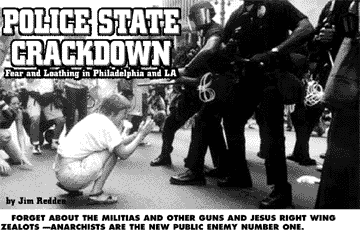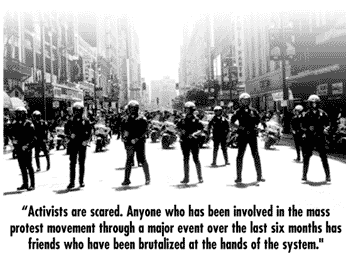
Ever since the World Trade
Organization protests in Seattle, the government has been
going after the Far Left with the same ferocity it attacked
the Far Right after the Oklahoma City bombing. The entire
anti-globalization movement has been denounced as violent.
Leaders have been arrested on trumped-up charges. Law
abiding political organizations are being infiltrated
by undercover operatives. Peaceful activists have been
accused of stockpiling biological weapons, explosives,
guns, and Molotov cocktails. And now law enforcement officials
are calling the movement a conspiracy and demanding a
federal investigation.
The WTO demonstrations in late 1999 caught the government
by surprise. Law enforcement agencies were unprepared
for the 50,000 activists who jammed Seattle’s streets,
broke windows, and battled the police on international
TV. But now the government has launched a counter-attack.
New protests have been met with overwhelming force. Over
2,500 protesters have been arrested so far this year.
The crackdown is being coordinated by the FBI, with the
support of the Pentagon, the Secret Service, the Bureau
of Alcohol, Tobacco and Firearms, and state and local
police agencies.
The new tactics were first used at the annual World Bank
and International Monetary Fund meeting last April in
Washington DC. Government officials repeatedly raised
the specter of violence to justify spying on the protesters
who came to town. Activists discovered their phones were
tapped, their meetings were infiltrated, and their movements
were monitored. Thousands of federal, state and local
law enforcement agents were mobilized. According to the
Paris-based Intelligence Newsletter, "reserve
units from the US Army Intelligence and Security Command
helped Washington police keep an eye on demonstrations
staged at the World Bank/IMF meetings."
Much of the information collected on the protesters went
into the Regional Information Sharing System (RISS) computers
used by more than 5,300 law enforcement agencies across
the country. Although RISS was created to track organized
crime networks, the government claimed the protesters
were domestic terrorists to justify adding them to the
database. "Among those considered as such (domestic
terrorists) at present are Global Justice (the group that
organized the April 17 IMF demonstration), Earth First,
Greenpeace, American Indian Movement, Zapatista National
Liberation Front and Act-Up," the Intelligence
Newsletter reported.
By the time the Republican National Convention began in
Philadelphia, the government had its tactics worked out.
Law enforcement officials warned of violence, justifying
their own and massive arrests. Activists reported that
unidentified people were photographing them. The Philadelphia
Inquirer identified two of the cameramen in the crowds
as undercover police officers. "We were watching,"
police spokesman David Yarnella confirmed. "We were
making surveillance efforts."
Shortly before the protests started, police raided a warehouse
where activists were painting signs and building large
puppets for their marches. Law enforcement officials claimed
the warehouse was being used to store C4 explosives and
acid-filled balloons, presumably to throw at police. The
police also impounded a bus which they said contained
poisonous snakes and spiders. Needless to say, no explosives
or weapons were found in the warehouse, and the animals
in the bus turned out to be harmless.
"It was a smart move by the police," noted
Free Radical editor L.A. Kauffman. "Stripped
of our means of communication, we looked as if we had
no message to convey."
Hundreds of people were arrested during the Republican
convention. The day after it ended, Philadelphia Police
Commissioner John Timoney called a press conference and
announced that he had uncovered a vast left wing conspiracy.
Sounding like anti-Communist fanatic Joe McCarthy, Timoney
declared that outside agitators had conspired to cause
violence and damage property. He called on the federal
government to investigate this subversive plot, saying,
"There is a cadre, if you will, of criminal conspirators
who are about the business of planning conspiracies to
go in and cause mayhem and cause property damage in major
cities in America that have large conventions or large
numbers of people coming in for one reason or another."
One "ringleader" identified by Timoney was John
Sellers, director of the non-violent Ruckus Society. Although
he was arrested on a series of misdemeanor charges, District
Attorney Cindy Mertelli asked that his bail be set at
$1 million. Mertelli showed the court a 27 page "dossier"
on Sellers, calling him "a real risk of danger to
the community" and noting he had been "involved
in Seattle, a situation with almost dead bodies."
Mertelli’s request was granted. But a later court
ruling dropped the bail to $100,000—still a hefty
chunk of change for misdemeanors.
Timoney's accusations got a boost when they were embraced
by Bruce Chapman, a former U.S. Ambassador to the United
Nations Organizations in Vienna. Writing in the Washington
Times, Chapman claimed the federal government wasn't
doing enough to identify and break up the conspiracy.
"The US Justice Department seems to have been lax
so far. Perhaps, therefore, it is time for Congress and
the media to investigate the rioters," he wrote.

Protesters faced a similar surveillance and harassment
campaign in Los Angeles. On July 13, the Los Angeles
Times printed a guest editorial by Mayor Richard Riordan
which warned of violence by "international anarchists."
Riordan claimed the protesters had attended "training
camps where they have learned strategies of destruction
and guerrilla tactics." Still the police didn’t
cut the media any slack. Two Chicago Tribune reporters
were arrested when they got too close to an anti global
capitalism bike rally that turned into a mass arrest.
The Tribune reporters were cited for things like
blocking a public thoroughfare and other nonsense while
trying to cover the event. The Tribune has publicly
declared they will sue the LA Police.
The possibility of domestic terrorism at the Democratic
Convention was raised on July 23 when the Secret Service
warned that protesters might release anthrax or some other
biological agent near the site of the convention. "We
have purchased a lot of equipment, specialized masks and
gowns," Dr. Robert Splawn, medical director of the
California Hospital Medical Center, told the LA Times.
On August 7, the Southern California chapter of the American
Civil Liberties Union complained about round-the-clock
police surveillance of the protesters. ACLU attorney Dan
Tokaji wrote to city officials, accusing the police of
videotaping activists and recording their license plate
numbers. "They've crossed the line separating legitimate
security preparations from unlawful harassment that violates
protesters' First and Fourth amendment rights. The mere
potential for a disturbance does not justify the suspension
of our constitutional rights," the letter said.
When the city didn't respond, the ACLU went to federal
court on August 11 and obtained a temporary restraining
order preventing the police from raiding the protest headquarters
without a warrant. In its complaint, ACLU lawyers cited
22 separate incidents of surveillance and harassment,
including random police visits without warrants, low helicopter
overflights, and people being followed and searched after
leaving the building.
But the injunction didn't stop the police from infiltrating
the activists. On August 12, a group met at the Luna Sol
Cafe to plan for the upcoming Mumia Abu-Jamal protest
march. As the meeting was breaking up, uniformed police
officers rushed through the cafe's front door and threw
three of the main speakers up against a wall. Several
of the meeting's participants also jumped up and helped
with the arrests, revealing themselves to be undercover
officers.
Activist/journalist Tim Ream revealed what was happening
in an August 10 dispatch from Los Angeles: "A disturbing
trend is developing regarding police preemptive response
to mass protest. In numerous situations since WTO protests
in Seattle in late 1999, police have issued misinformation
claiming unsubstantiated evidence of violent plans by
protesters gathering for mass actions. The false information
is then used as a pretext for unwarranted police actions.
The misinformation concerning protester plans has ranged
from chemical weapons to bomb-making. None of the numerous
claims of violent plans have been substantiated. Nonetheless,
many media outlets appear to have been predisposed to
repeat information provided by police without fact-checking
or seeking responses from the organizations accused. The
damage to free speech and the mass protest movement has
been extensive." The scenario above was self-evident
in the May Day protest-turned-police debacle here in Portland.
Hundreds more protesters were arrested during the four-day
Democratic National Convention, including a number who
had apparently been identified as "leaders"
by undercover operatives. They were all given high bail
to ensure they would not be released until they had identified
themselves and their names were entered into the growing
computer database being compiled by the government.
By the time the convention ended, even activist Tim Ream
admitted the crackdown is working: "Editorial pages
and conversations on the street are full of critiques
that protesters are not clear about what they stand for
and seem more interested in violence than meaningful change.
This is as clear a sign as any that protester voices have
been effectively silenced and police positioning of protesters
is carrying the day," he wrote. "In addition,
activists are scared. Anyone who has been involved in
the mass protest movement through a major event over the
last six months has friends who have been brutalized at
the hands of the system."
After staging highly-visible mass demonstrations in Seattle,
Washington DC, Philadelphia and Los Angeles, protest organizers
now face their greatest challenge—keeping the anti-globalization
movement going in the face of growing police state tactics.





